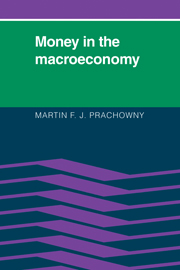Book contents
- Frontmatter
- Contents
- List of charts, figures, and tables
- Preface
- List of symbols
- 1 The roles of money and monetary policy in the macroeconomy
- 2 A model of the macroeconomy
- 3 The new classical model: the case against stabilization policy
- 4 The institutionalist model: the case for stabilization policy
- 5 The demand for money
- 6 The supply of money
- 7 The monetary mechanism
- 8 U.S. monetary policy and the dilemma of stagflation
- 9 A model of an open economy
- 10 Managed exchange rates and monetary policy
- 11 Monetary policy in Canada and its macroeconomic consequences
- 12 Improving the monetary policy apparatus
- Index
8 - U.S. monetary policy and the dilemma of stagflation
Published online by Cambridge University Press: 26 October 2011
- Frontmatter
- Contents
- List of charts, figures, and tables
- Preface
- List of symbols
- 1 The roles of money and monetary policy in the macroeconomy
- 2 A model of the macroeconomy
- 3 The new classical model: the case against stabilization policy
- 4 The institutionalist model: the case for stabilization policy
- 5 The demand for money
- 6 The supply of money
- 7 The monetary mechanism
- 8 U.S. monetary policy and the dilemma of stagflation
- 9 A model of an open economy
- 10 Managed exchange rates and monetary policy
- 11 Monetary policy in Canada and its macroeconomic consequences
- 12 Improving the monetary policy apparatus
- Index
Summary
INTRODUCTION
During the past 10 years the U.S. inflation rate has been on a roller-coaster ride. Twice, during 1973–75 and again during 1979–81, the inflation rate rose dramatically, giving rise to fears of unstoppable hyperinflation, only to drop again almost as dramatically. In addition, during these episodes, output fell and unemployment rose. This unfortunate combination of inflation and recession has been dubbed “stagflation.” Monetary policy played a prominent role in this stagflationary decade, and it is the purpose of this chapter to review and analyze the part played by the Federal Reserve's conduct of monetary policy in greater detail than was possible in previous chapters. It is not intended merely to record the events since 1972 but instead to fit them into the analytical framework formulated in Chapters 2–7. From the IS-LM-AS model it is possible to make a number of predictions about the macroeconomic consequences of policy changes or unpredictable shocks; these predictions will then be tested against the evidence of the time to see how.useful the IS-LM-AS model is in such a turbulent period.
In a sense, this is a case study; it is an attempt to use the macro model to analyze a specific real-world situation. At the same time, it should not be construed as the final word on the events that transpired during this period; there is not enough historical perspective for that.
- Type
- Chapter
- Information
- Money in the Macroeconomy , pp. 210 - 234Publisher: Cambridge University PressPrint publication year: 1986



